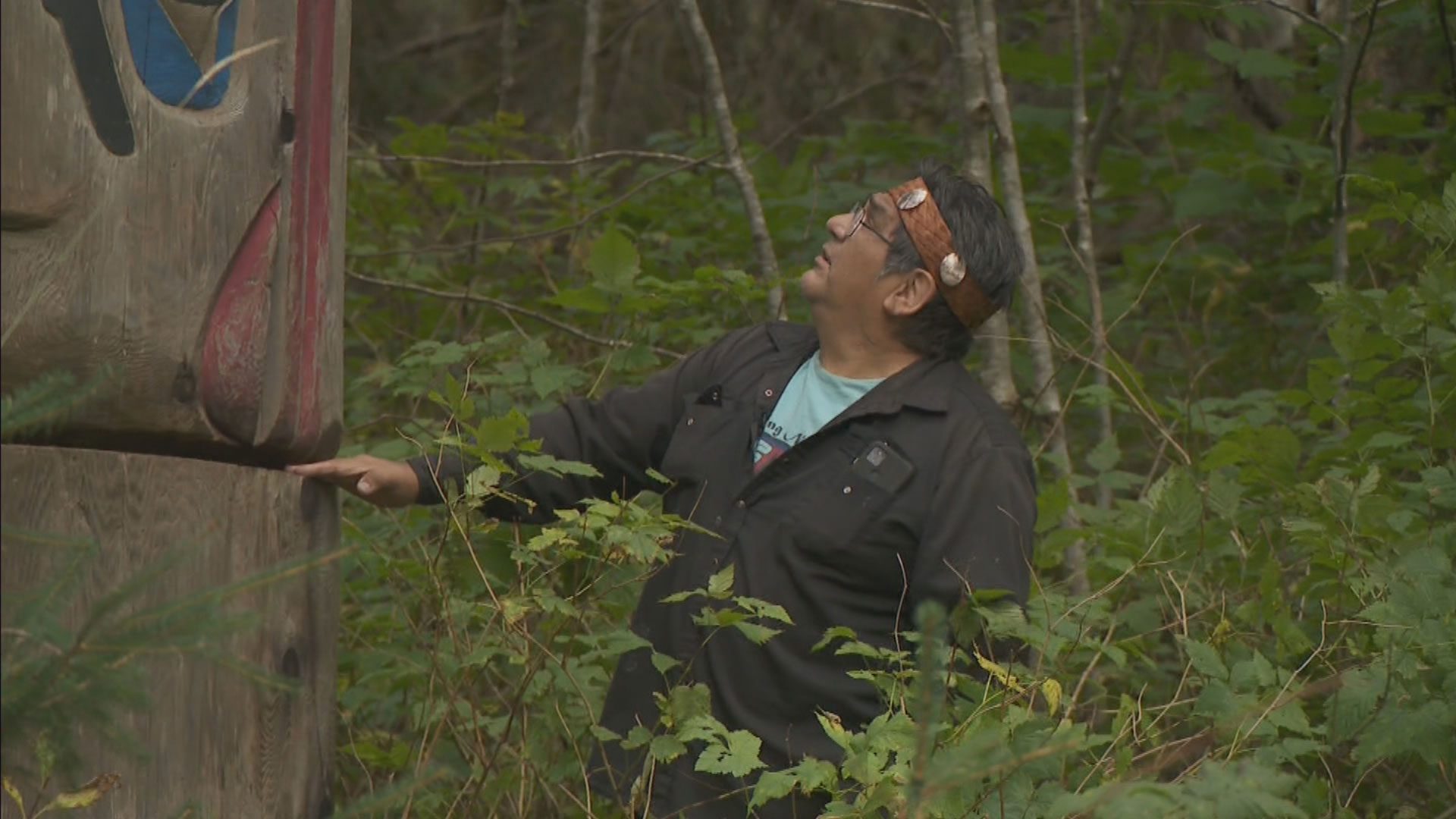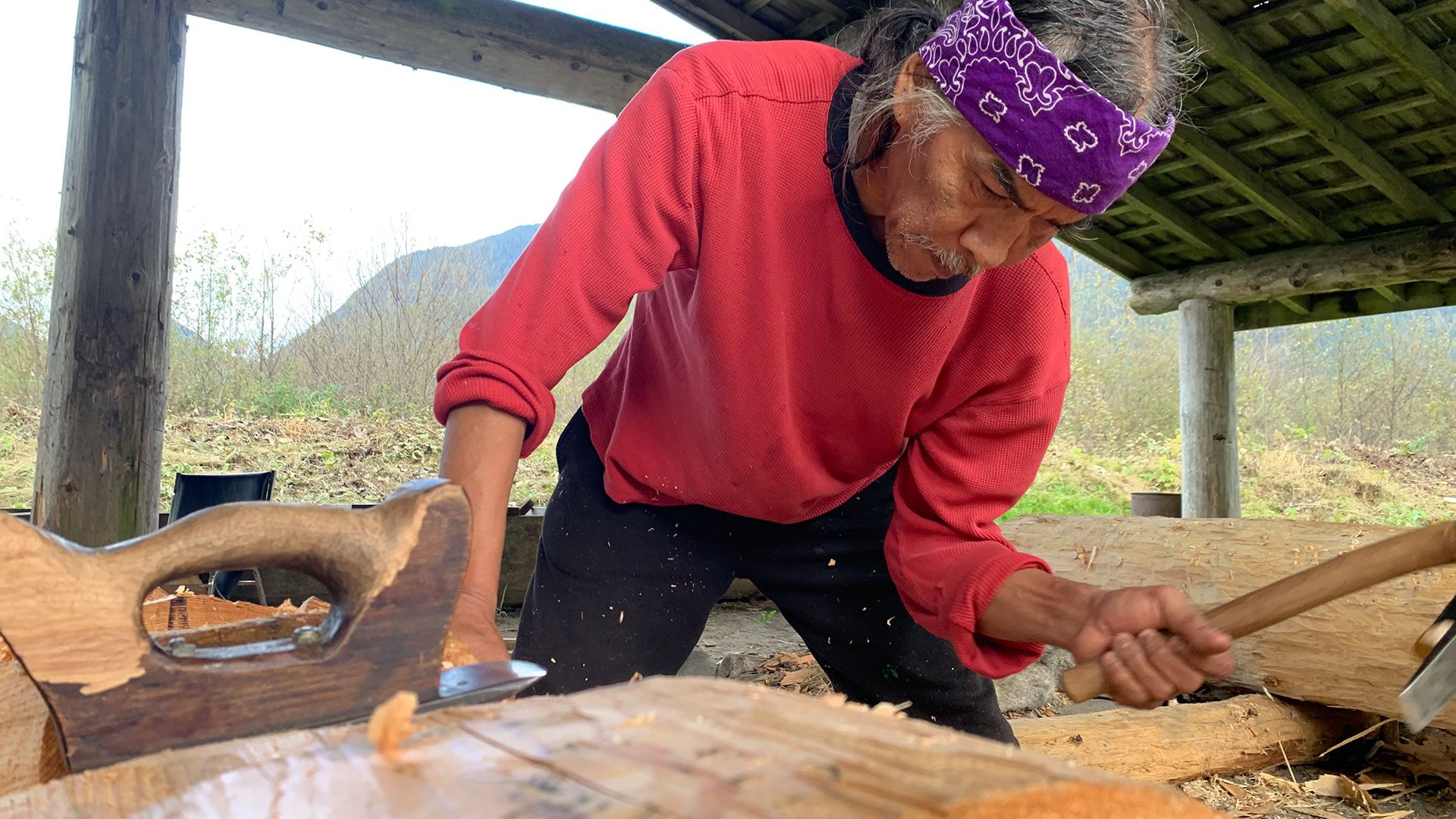The Nuxalk Nation is deploying an ancient mode of resistance to stop the potentially devastating effects of gold mining from coming to their territory.
They’re carving and putting up three new totem poles in locations being studied by the Vancouver mining exploration company Juggernaut in the mountain tops around Bella Coola, British Columbia – where the Nuxalk community is based.
“We want to tell the world that we are still Nuxalk’mc – we are still alive and we are still here,” says Hereditary Chief Snuxyaltwa – also known as Deric Snow – in the APTN Investigates episode Reawakening the Mountains.
But it isn’t just hereditary chiefs standing up for Nuxalk territory – it’s the band council, too.
A recent letter to B.C.’s provincial mining inspector from the band’s stewardship director says permits granted to Juggernaut Exploration violate the United Nations Declaration on the Rights of Indigenous Peoples, which was made law in BC in 2019.
“Nuxalk Nation opposes all mining activities, including exploration, on its Lands and Waters,” states the letter from Nuxalk stewardship director Sam Pascoe, dated Sept. 28, 2022.
APTN reached out to Juggernaut Exploration – which is in the business of determining if locations it studies are viable for mining – on multiple occasions but they declined to comment for this story.
However, in an interview posted on YouTube, Juggernaut CEO Dan Stuart describes what his company is finding on Mount Pootlass – the peak where Nuxalk lore says people originally descended from Nusmata [the heavens].
“We’re finding veins that are a thousand meters in strike length – that’s a kilometer – 20 meters wide – and they’re running up to three-and-a-half ounces of gold located right on tidewater, and the town is only four-and-a-half kilometers away. Very rare to find anything at the surface these days that was never known before,” says Stuart.

Juggernaut reported $500,000 in exploration expenditures near Bella Coola at the end of 2021 and expects to have spent another $2 million there by the end of 2023.
Reawakening the Mountains opens with a visit to a totem pole that marks the location of a former Nuxalk village on the shore of the South Bentinck Arm, and there, Snow makes the case for his people’s right to defend the area they’ve lived in since time immemorial.
“We have a sovereign territory, it’s un-treatied,” says Snow, “we have never signed a treaty with any government and we have never okayed them to destroy any of our territories.”
Snow sees the three new totem poles as a way to stimulate a comeback of sorts for the stories the Nuxalk have long told about their connection to the surrounding mountains.
“It’s going to bring back the story of that mountain,” says Snow, referring to Mount Pootlass, where the Nuxalk creation story begins. “It’s going to bring back all the history of each and every one of our families that lived there.”
Snow sees parallels between protests against logging in Nuxalk territory in the 1990s and the new push to stop mine development.
But it’s also a little different he says.
“Back then it was a direct action. Now it’s spiritual,” says Snow. “So the government now has to face our Nuxalk spirit in order to mine. They cannot put handcuffs on a totem pole.”
But it isn’t just about reviving Nuxalk spirit – it’s about defending an ecosystem in the balance.
Of special concern to the Nuxalk community is eulachon, a fish of great traditional importance to the Nuxalk community, renowned for its fat.
Jason Moody is the fisheries and wildlife manager with the Nuxalk Stewardship Office. He has been involved in efforts to try to revive the region’s eulachon population, which dropped dramatically in the late 1990s.
Like just about all Nuxalk people given the chance, Moody waxes poetic about eulachon grease.
“It’s like the most important thing, right? If you can make grease, it’s one of the highest in nutrients,” says Moodie. “The amount of good fatty acids that are in that are amazing like it’s been talked about that the contents of eulachon can actually offset cancer. And you can put it into any container really, and it doesn’t go bad.
“So when you talk about our ancestors having the long houses, no refrigerators or deep freezers or anything like that, grease was just kept in cedar boxes. I’ve heard of stories when old glass jars and containers full of eulachon grease were forgotten about under somebody’s house. Twenty years later – ‘oh, there it is’ and pull it out – still good.”

Juggernaut is in the business of exploration, not mine development, so it’s not clear what type of mine operation could be coming to the Bella Coola area. But gold mining is often destructive to mountains and surrounding ecosystems – especially if it is an open pit mine.
That’s what worries Nuxalk Hereditary Chief Anuspuxals – also known as Jeffrey Snow.
“If they do that, then basically that mountain will be leveled or most of it taken down – and that would be terrible because of all the runoff,” says Snow.
Some of the concerns about runoff from an open pit mine involve arsenic, which gets separated from gold during the extraction process and is one of the poisons that can end up in the water.
That’s a potential problem for the eulachon as well as other living beings trying to survive in that ecosystem.
As the saying goes – water is life – and that’s a sentiment that hits close to home for Nuxalk Nation’s elected Chief Councillor Tlhmtimut, also known as Samuel Schooner.
“I ain’t been dishonest by saying this, but we have the best water in the world,” says Schooner. “It’s glacial water – it’s just amazing. And so thought of risking losing all of that for mining operations – there’s no accountability. If something happens to our land, they get to walk away with nothing. And so how can we let that happen?”

Nuxalk people in Bella Coola told APTN that supernatural beings don’t like the incursions into areas that are being looked at for mining.
“They let us know that they are being bothered,” says Hereditary Chief Q’umulha – also known as Rhonda Schooner Sandoval, “and so knowing that these helicopters are going over there, they’ve been coming forward and showing some of our children and some of our people are talking about how they’re showing themselves.
“It’s because things are happening that are not supposed to happen and we’re not having respect for them.”
The three new totem poles being carved to defend Nuxalk territory are expected to go up in the spring of 2023.
A Nuxalk totem pole carved by Deric Snow’s great-grandfather Louis Snow and currently held by the Royal British Columbia Museum is expected to be returned to the community soon, possibly by mid-December 2022.
This story was updated on Nov. 19.












